Where art meets science
Two new sculptures on Seldin Plaza expand dazzling art collection and inspire campus community

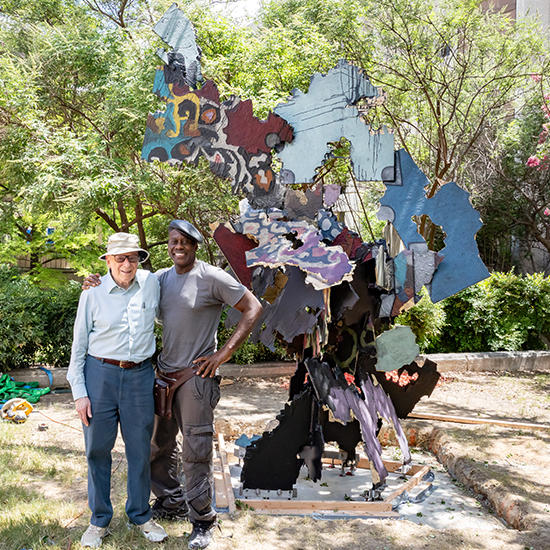
UT Southwestern’s Donald Seldin Plaza has become a treasured campus environment that stimulates the mind and senses with a collection of sculptures by internationally renowned artists. Recently, two new sculptures were installed: Idee di Pietra – Acero (Ideas of Stone – Maple), 2020, by Giuseppe Penone, and 236T, 2024-25, by Leonardo Drew, representing the 10th and 11th outdoor works acquired through the generosity of Nobel Laureate Joseph L. Goldstein, M.D., Chair of Molecular Genetics.
“Dr. Goldstein’s generosity and vision for a sculpture garden are perhaps unprecedented on the campus of an academic medical center,” said Courtney Crothers, UT Southwestern’s art curator. “The quality of the sculptures on Seldin Plaza, their placement, and their visual and thematic variety create a richly layered and dynamic experience for the UTSW community and all visitors to campus.”
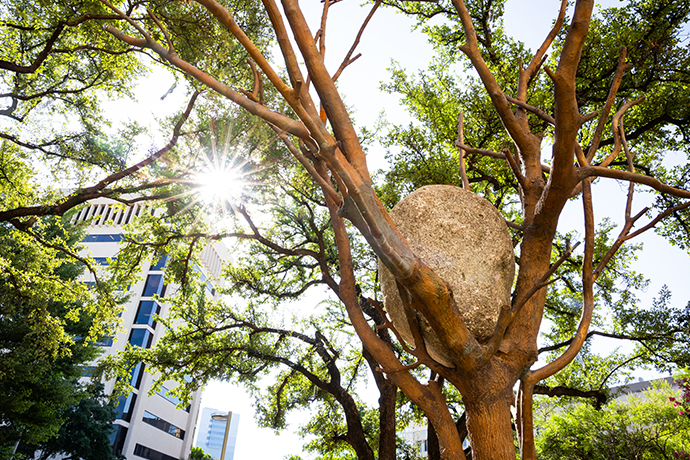
Idee di Pietra – Acero
Idee di Pietra – Acero (Ideas of Stone – Maple) is a bronze sculpture about 18 feet tall with a large river stone nestled at the apex of four intertwined trunks, below a crown of leafless branches. The gravity-defying structure was created by Giuseppe Penone, an internationally acclaimed Italian artist who lives and works in Turin, Italy, and is recognized for his large tree-inspired works.
Mr. Penone was born in 1947 in Garessio, Northern Italy, where forested landscapes deeply influenced his practice and shaped his lifelong exploration of the hidden bonds between humans and nature. His works are based on objective reality, such as landscapes, river stones, and trees, and reveal nature’s hidden structures, rhythms, and gestures.
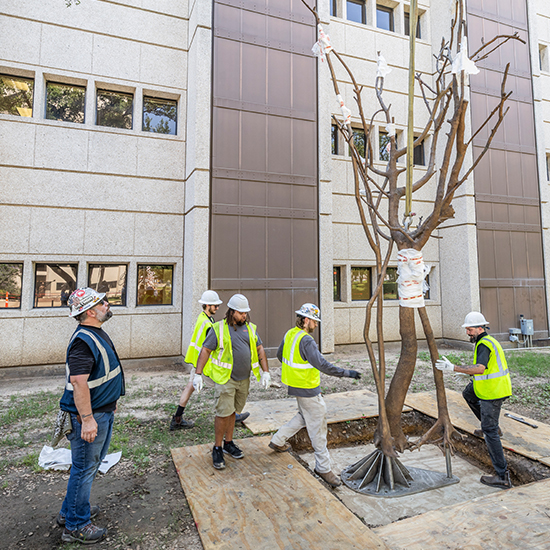
Dr. Goldstein has followed Mr. Penone and his work for decades.
“Through his art, Penone tells us that a great idea does not arise in an explosive moment but rather forms in a very slow process of aggregation and crystallization, such as that which occurs in the formation of a rock,” he said.
The artist describes river stone as a type of granite rock that contains billions of crystals of silicate minerals, formed over many years by the natural processes of weathering and erosion. Mr. Penone purposely selected a stone that calls to mind the shape of the human brain, thus relating the stone’s billions of crystals – each with a precise geometry – to the mind’s capacity for order and logic and its billions of neurons producing great thoughts.
For Dr. Goldstein, the work represents human ideas that, like stone burnished by flowing water, are polished by the passage of time, compacted by the weight of memory.
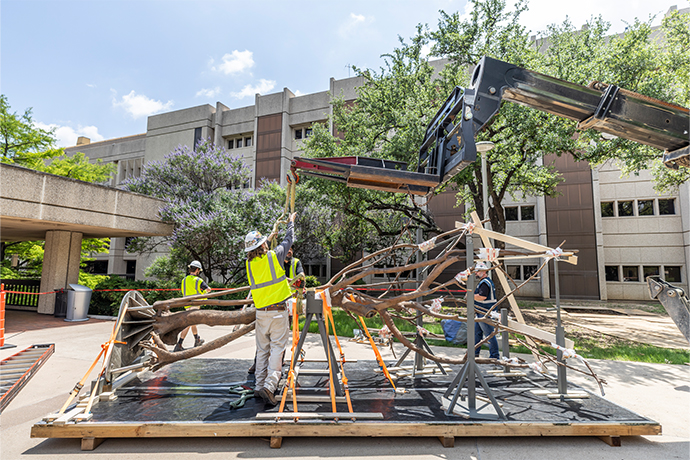
236T
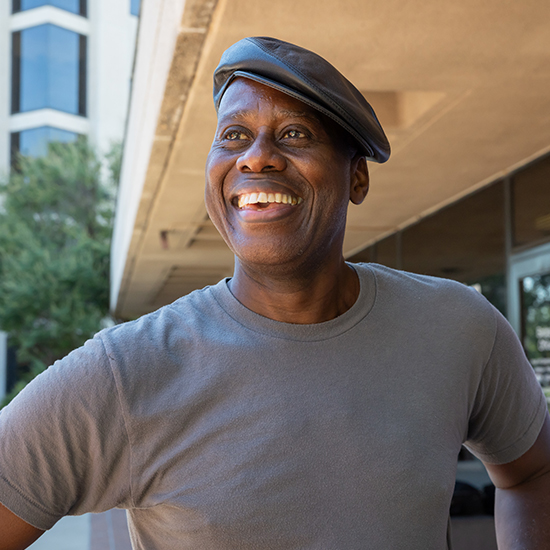
In contrast to Mr. Penone’s reference to nature and natural phenomena, a new, neighboring sculpture by Brooklyn-based contemporary artist Leonardo Drew represents painstaking human fabrication and the state of urban America. 236T, 2024-25, was created in cast, painted aluminum and stands 12½ feet tall. The sculpture’s colorful, explosive planes – intricately painted in the traditional trompe l’oeil method to mimic shards of plywood – add a compelling presence to Seldin Plaza.
Mr. Drew is best known for his contemplative, abstract wall reliefs that play on the tension between order and chaos, and his full body of work, most recently including three-dimensional sculptures such as the piece installed on Seldin Plaza, serves as a critique of social injustices and a meditation on the cyclical nature of existence. His work has been widely exhibited locally and internationally.
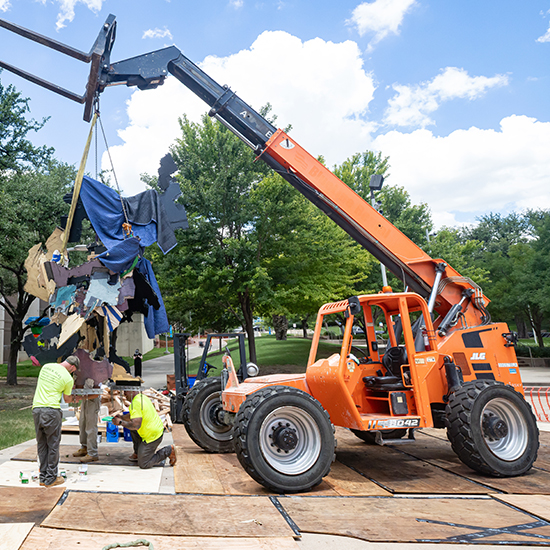
The artist grew up in Bridgeport, Connecticut, and memories of his childhood surroundings – from the housing project where he lived to the adjacent landfill – reappear in the intricate grids and chaotic compositions of his artwork.
His purposeful “weathering” of new materials uses processes of oxidation, decay, burning, and breaking. These reflect his personal experiences as a man who grew up in poverty and his long-standing fascination with the life cycle of material decomposition and transformation.
Mr. Drew prefers not attaching specific meaning to individual works through narrative titles. Instead, his titles are derived using a system of numbers and letters (in the present case, the “T” stands for Texas) so that the viewer can engage directly with the installation and discover personal resonance within it.
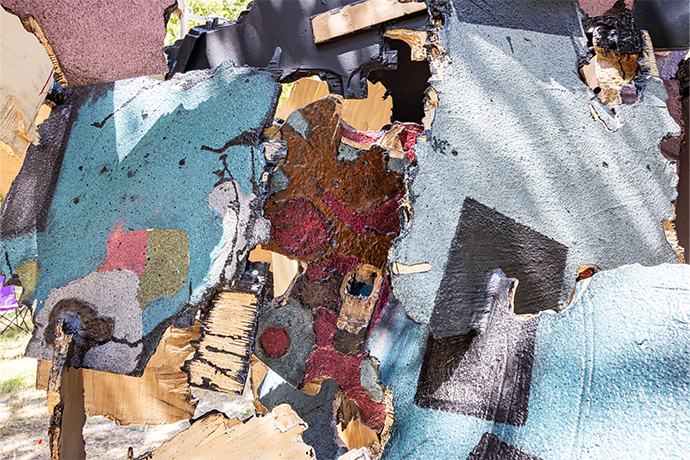
Growth of a sculpture garden
All 11 pieces donated by Dr. Goldstein to date are installed on or near Seldin Plaza and offer additional opportunities for intellectual growth beyond UT Southwestern’s mission-driven tradition of scientific mentorship. Each work tells its own unique story: Dallas Mountain, 2023, a tower of boulders in rich, vivid colors by Ugo Rondinone; Plantoir, Blue (Mid-Scale), a 15-foot blue garden trowel, by the late Claes Oldenburg and Coosje van Bruggen; Elmgreen & Dragset’s Life Rings, Fig. 2, a monumental arrangement of red-and-white life preservers stretching skyward; Dumna, by Ursula von Rydingsvard, a sculpture resembling natural wood or stone with a colorful patina; two untitled works by the late Joel Shapiro, whose uncannily figurative geometric forms achieved international acclaim; an untitled copper-plated steel piece by Christopher Wool, modeled on tangles of fencing wire; and two cast bronze sculptures, Thistle 1 and High Rise 2, by influential Texas artist Joseph Havel. The Plaza also contains a bronze sculpture of Donald W. Seldin, M.D., first Chair of Internal Medicine and one of the guiding forces in UT Southwestern’s history, by Philadelphia-based sculptor Zenos Frudakis.
Dr. Goldstein and his lab partner of over 50 years, Nobel Laureate Michael Brown, M.D., Professor of Molecular Genetics and Director of the Erik Jonsson Center for Research in Molecular Genetics and Human Disease, shared the 1985 Nobel Prize in Physiology or Medicine for their discovery of the low-density lipoprotein receptor and its role in cholesterol metabolism.
Dr. Goldstein’s laboratory is steps away from Seldin Plaza, where the sculpture garden provides regular inspiration for his thoughts. Through his generosity, he has created a magnificent outdoor space that offers moments of respite, curiosity, contemplation, and discovery.
Endowed Titles
Dr. Brown, a Regental Professor, holds the W.A. (Monty) Moncrief Distinguished Chair in Cholesterol and Arteriosclerosis Research and the Paul J. Thomas Chair in Medicine.
Dr. Goldstein, a Regental Professor, holds the Julie and Louis A. Beecherl, Jr. Distinguished Chair in Biomedical Research and the Paul J. Thomas Chair in Medicine.

